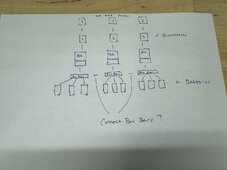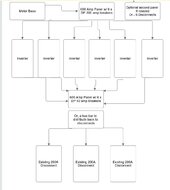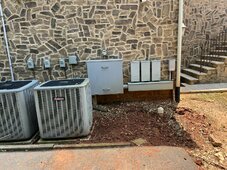Put the Grid inputs of all the inverters together into an AC combiner box fed from your 600(?) amp main feed.
Put the Load outputs of all the inverters together into a different AC combiner box. It should be rated for at least 50 amps times the number of inverters you have.
Connect a minimum of two PowerPro batteries to each inverter.
Use the busbars on the batteries to connect the batteries together.
Use parallel RJ45 cables between the inverters (see the manual for details).
Set one inverter to Master and the others to Slave as per the manual.
To be clear, the way it works now is the grid power goes into a trough where there are bus bars that connect the meter to the lines that run to each of the 3 disconnects (that then go to the panels inside the house).
So I suppose this would stay the same except from those bus bars I would run to the inverters, then out of the inverters and to another set of bus bars, then back into the disconnects. Or, how do the
Put the Grid inputs of all the inverters together into an AC combiner box fed from your 600(?) amp main feed.
Put the Load outputs of all the inverters together into a different AC combiner box. It should be rated for at least 50 amps times the number of inverters you have.
Connect a minimum of two PowerPro batteries to each inverter.
Use the busbars on the batteries to connect the batteries together.
Use parallel RJ45 cables between the inverters (see the manual for details).
Set one inverter to Master and the others to Slave as per the manual.
Thanks a lot for this. I didn't even see your reply till after I called Signature Solar and talked to their techs today and they basically said the same thing you just said.
What I am thinking about right now and trying to figure out how to deal with is what all pieces should be where. Here is something I drew just now. I took a look on ebay (just to gauge what a 600 amp panel costs) and holy cow! I am hoping you guys or one of the electricians has some sort of idea about how to go about this cheaper.
I am also including an image of my current electrical setup. The trough in the bottom right is where the grid power comes in from the meter (left). In the trough there are bus bars where they just connect together those wires with the wires that are going into the 3 disconnects you see above it.
I am imagining coming from the meter, through the trough, out the bottom of it, in conduit over to where the solar stuff will be, into the 600 amp panel I have drawn (or possibly 6 disconnects if that is possible / easier / cheaper), then you can see the rest on the drawing. The wires from the "combiner box" exiting the inverters would go in conduit, back into the trough, and back into the disconnects going into the house.
Thoughts?






